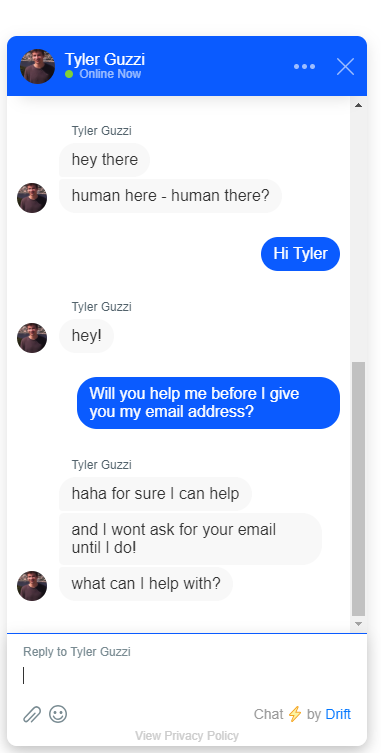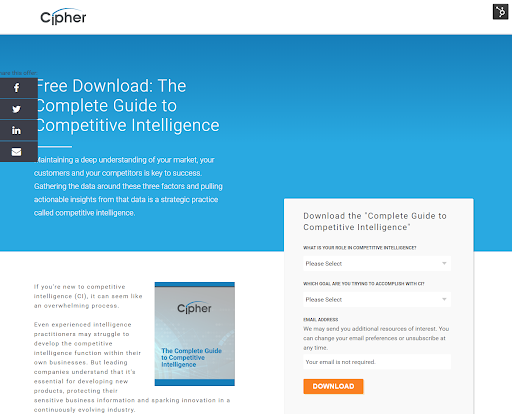Subscribe now and get the latest podcast releases delivered straight to your inbox.
To quote Gary V, from his INBOUND12 keynote address, “Marketers F#$% everything up.”
The first time I heard him say this was at HubSpot's annual INBOUND event. This keynote was also the first time I heard a speaker drop the F-Bomb. (He actually dropped it 84 times in a 60-minute talk - I know because I counted).
In a later interview with Inc. Magazine, he went on to explain how “marketers ruin everything.”
Gary’s point was this: When we marketers find something that buyers find valuable, we exploit the hell out of it until our buyers are jaded and turned off.
The result? You got it - it doesn’t work anymore.
Need proof? Think about banner ads. When was the last time you clicked on a banner ad?
The first banner ad was purchased by AT&T and appeared on HotWired.com in 1994. It returned a 44% click-through-rate. That ROI would be unheard of today.

Now, think about email.
How many pieces of content have you not downloaded because you’re pretty sure doing so would’ve unleashed a firestorm of emails from the content provider and every other company they share or sell their lists to?
Your prospective buyer likely has done the same. For them, it’s just no longer worth it.
So, what’s a marketer to do?
I’ll tell you what. Don’t ask for their email.
"What?!" you say?
"How am I supposed to know who they are?"
You aren’t.
"How will I nurture those leads?"
You won’t.
"What will I pass to the team of eager-beaver sales reps sitting next to me?"
Nothing.
Before we get into the tactics of what you should do (and we will get there), let’s be honest with each other.
You Don’t Need Everyone’s Email Address
For most companies - companies that make things, service things, or deliver things - knowing a prospect's email address at the beginning of a conversation is not necessary.
Not only that - asking for it doesn’t increase your value or trustworthiness in the eyes of a prospective buyer.
Say I work at a software company that helps you gather market research, identify market trends, and better understand what your competition is doing in your industry (which I do).
When you first discover us, knowing if you already use the type of software I'm selling is far more important to me than knowing your email address. And getting helpful information that you can actually use is more important to you than giving me your email address.
Yes, at some point I will need your email if I am going to initiate an interaction with you, but for now - in our first interaction - I don’t need it.
And let’s be honest. At this point, you probably aren’t even sure if I have anything meaningful to say. And until you do, why would you agree to hear from me again?
My advice?
Let your prospects see what you have to offer before you say your digital-nuptials and exchange email.
Buyers are jaded and cynical and I don’t blame them. Most of us marketers do too much
How many “Free eBook” offers have you seen that look more like PowerPoint slides with a paragraph of 45-point text than any book you might check out at your local library?
And we want people to give us their emails for that? I don’t think so…
It’s Time to Make a Change
Most of us fear change.
Change is by its very nature different. That’s why it's changed.
But whether we like it or not, change is all around us. Your company is changing, your market is changing, and your competitors are changing. In turn, choosing not to change is not a winning strategy.
I believe our abuse of email and content marketing is a significant contributor to the lightning-fast adoption of what Drift CEO David Cancel calls conversational marketing.
In his book, HYPERGROWTH, he talks about how the customer-driven model is changing the way businesses connect with buyers.
Chat tools like Drift feed our inner “Veruca Salt: I want it Now!” desire. (She was the bratty child from Charlie and the Chocolate Factory).
They also allow the buyer to remain anonymous.
Not only can prospective buyers get their answer immediately when they chat on our websites, via human or bot, but they can also do so without having to share their name or email address.

Not giving up their email address means they don’t need to worry about deleting all those unwanted messages we may be planning on sending from the automated lead nurturing workflow they never asked to join.
Instead of jumping in and asking for our prospects’ email addresses right of the gate, we as marketers would be better served by focusing on delivering value by helping our prospects, answering their questions, and giving them the information they need to solve their problems - without asking for anything in return.
(Note: If you want to learn more about Drift, reach out to Tyler, he's a real person and really helpful - even before you give him your email.)
Always Solve for the Buyer
At the most fundamental level, my goal as a marketer is to build trust and establish credibility with my prospects.
I do this by sharing my company’s perspective, experience, and intelligence in a way that is educational and designed to answer their questions and help them solve their problems.
Doing all of this without asking for an email address is a very effective way to build trust and credibility, and it makes great business sense.
Liz Murphy, Director of Web and Interactive Content at IMPACT recently shared how:
“Ungating our content didn't hurt our lead flow at all. To the contrary, by sharing our content with our website visitors, we've been able to demonstrate the value that we provide through our content and if anything, it has resulted in a higher visitor-to-lead conversion rate, and more qualified bottom of the funnel leads."
I’m Practicing What I Preach
In my role as VP of Marketing at Cipher Systems, I’m measured by the number of qualified leads I deliver to our sales team. We’re a SaaS company that sells competitive intelligence software, and one of our primary top of the funnel offers is a “Guide to Competitive Intelligence.”
Last month, I decided to experiment with making the email field on the conversion form for this offer not required. Visitors to our site can get the guide whether they give us their email or not - it’s their choice. What is required are the answers to two questions: 1) what is your role in competitive intelligence? and 2) which goal are you trying to accomplish with CI?
This information is much more relevant to me at this early stage in our relationship with the buyer than their email address is, and I’m betting on the quality of our content to make an impression and convince our visitors that it’s worth coming back to our site - and eventually giving us their email address.
Want to check it out? Fill out the form and make sure you don’t give me your email address when you do so.
My Results
Eliminating the requirement for prospects to give us their email address when downloading our Guide to Competitive Intelligence may seem like a risky move for someone, such as me, whose job performance is judged by metrics like lead conversions.
The good news is that my bet paid off and in the month since I implemented this change on our form, the number of new contacts we’ve gotten from the offer has increased by 900%.
Yup - you read that right - that is a 900% increase in new contacts simply by removing the requirement for prospects to give us their email address.
Needless to say, I plan to roll out a similar change on several of our other top of the funnel forms.
Why You Should Ditch the Email Address Requirement
To clarify, I'm not suggesting that you never ask for a prospect's email address - just that you consider eliminating the need for it on some (or all) of your top of the funnel forms.
You might be reading this and thinking, “What if I share my content and offers without asking for an email address, and my prospect doesn’t come back?”
That is definitely a risk that you run with this approach, and the reality is that your marketing performance, as you measure it today, may very well decline. This approach doesn't work well if your content stinks.
But, if you're creating truly educational and helpful content, there are a few reasons why taking this approach is worth the risk:
1. Increase Conversion Rates
There is a good chance that when you do this, you’ll see a reduction in the overall number of new email addresses that get added to your database every month. Why? Because every single website visitor who wants to see your content will no longer need to give you their contact information in order to do so.
The reduction in new contacts with email addresses may very well be offset by an increase in your visitor-to-lead conversion rates, as IMPACT saw. Why? Once your visitors see your content and realize that it delivers real value, they will actually be more willing to give you their email address because they'll feel confident that any future outreach on your part will continue to add value.
2. Better Quality Leads
The quality of your leads will likely increase because the people who actually do convert on your forms will do so not because they want your eBook, but because they actually want to engage with you.
If you're like me, and your performance is measured at least in part by the quality of leads you deliver to your sales team, this is a huge win.
A Win-Win For Marketers and Buyers
The next time you ask a buyer for her email address, first ask yourself, “Will this help my buyer, or is this only helping me?”
Marketers who place the buyer’s needs first and give before they ask to receive will always build trust and credibility within their markets - and buyers will reward them for it.


Order Your Copy of Marcus Sheridan's New Book — Endless Customers!


